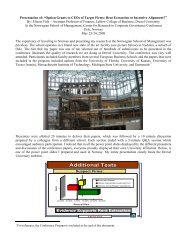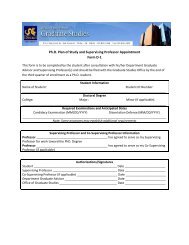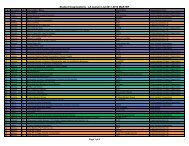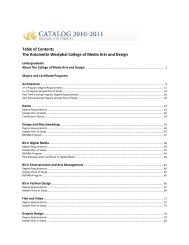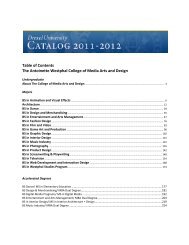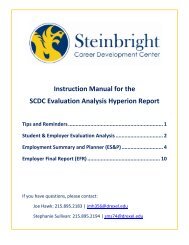Taxability of Graduate Tuition Remission for ... - Drexel University
Taxability of Graduate Tuition Remission for ... - Drexel University
Taxability of Graduate Tuition Remission for ... - Drexel University
You also want an ePaper? Increase the reach of your titles
YUMPU automatically turns print PDFs into web optimized ePapers that Google loves.
<strong>Taxability</strong> <strong>of</strong> <strong>Graduate</strong> <strong>Tuition</strong> <strong>Remission</strong> <strong>for</strong> Employees<br />
<strong>Drexel</strong> <strong>University</strong> <strong>of</strong>fers employees the opportunity to pursue higher education free <strong>of</strong><br />
charge. This exceptional benefit is <strong>of</strong>fered <strong>for</strong> both undergraduate and graduate<br />
coursework. While undergraduate tuition remission is generally not taxed, the Internal<br />
Revenue Service has ruled that the graduate tuition benefit is taxable income.<br />
WHEN IS TUITION REMISSION TAXED?<br />
In general, IRS regulations consider anything <strong>of</strong> value provided to an employee by an<br />
employer to be a <strong>for</strong>m <strong>of</strong> compensation. All compensation must be reported as taxable<br />
wages and is subject to income tax withholding, unless specifically excluded by the<br />
Internal Revenue Code.<br />
Under section 117(d) <strong>of</strong> the Internal Revenue Code, educational institutions <strong>of</strong>fering a<br />
full reduction <strong>of</strong> tuition charges to employees, their spouses and dependent children <strong>for</strong><br />
undergraduate coursework may exclude the value <strong>of</strong> this education from their employees’<br />
taxable wages. The exclusion under this section does not extend to graduate coursework.<br />
Section 127 <strong>of</strong> the Code allows all employers, whether or not they are an educational<br />
institution, to provide their employees with educational assistance <strong>for</strong> both undergraduate<br />
and graduate work. Employers may provide each employee with up to $5,250 <strong>of</strong><br />
educational assistance per year on a tax-free basis. The tuition remission that the<br />
<strong>University</strong> <strong>of</strong>fers employees <strong>for</strong> graduate-level education is eligible <strong>for</strong> this exclusion.<br />
The Internal Revenue Code requires that educational assistance in excess <strong>of</strong> the $5,250<br />
exclusion must be added to employees’ taxable wages and employment taxes must be<br />
withheld.<br />
WHAT HAPPENS TO THE TAXES THAT ARE WITHHELD?<br />
The additional taxable income and taxes withheld are reported on the W-2 <strong>for</strong>m. The<br />
<strong>University</strong> is required to issue W-2 <strong>for</strong>ms to employees by January 31 st to provide the<br />
in<strong>for</strong>mation necessary <strong>for</strong> completing their tax returns. Educational assistance in excess<br />
<strong>of</strong> the excludable amount is subject to federal, Social Security and Medicare taxes. The<br />
table below shows how the taxable tuition remission and taxes are reported on the W-2<br />
Form <strong>for</strong> a tuition benefit worth $5,000 over the $5,250 exclusion.<br />
Type <strong>of</strong> Tax W-2 Taxable Wages W-2 Taxes Withheld Percent<br />
Federal Income Tax Box 1 $5,000.00 Box 2 $1,250.00<br />
Social Security Box 3 $5,000.00 Box 4 $310.00<br />
Medicare Box 5 $5,000.00 Box 6 $72.50<br />
25%<br />
Supplemental rate<br />
6.2%<br />
Up to $6,324.00/year<br />
1.45 %<br />
Unlimited
<strong>Taxability</strong> <strong>of</strong> <strong>Graduate</strong> <strong>Tuition</strong> <strong>Remission</strong> <strong>for</strong> Employees<br />
Total Taxes $1,632.50 32.65%<br />
Example: An employee who has received $10,250 in tuition remission benefits <strong>for</strong><br />
graduate-level coursework would have $5,000 <strong>of</strong> additional taxable income reported in<br />
boxes 1, 3 and 5 <strong>of</strong> his/her W-2 ($10,250 tuition remission received less $5,250<br />
exclusion) at the end <strong>of</strong> the year.<br />
Federal income tax withheld <strong>for</strong> the year (reported in box 2) would be $1,250 ($5,000<br />
additional taxable wages * 25% withholding rate) more than the amount withheld against<br />
wages alone. Social Security tax withheld <strong>for</strong> the year (reported in box 4) would be $310<br />
($5,000 additional taxable wages * 6.2% tax rate) more than the amount withheld against<br />
wages alone, and Medicare tax withheld <strong>for</strong> the year (reported in box 6) would be $72.50<br />
($5,000 additional taxable wages * 1.45% tax rate) more than the amount withheld<br />
against wages alone.<br />
The additional $1,632.50 in taxes ($1,250 federal + $310 Social Security + $72.50<br />
Medicare) due on the additional income must be withheld from the employee’s<br />
paychecks.<br />
HOW IS THE TAXABLE BENEFIT DETERMINED?<br />
Each month, Payroll receives a report indicating the total dollar amount <strong>of</strong> tuition<br />
remission received by employees <strong>for</strong> graduate-level education during the current calendar<br />
year. This report totals tuition remission <strong>for</strong> the winter, spring, summer and fall terms, as<br />
applicable. If the amount received by an employee exceeds the annual excludable<br />
amount ($5,250), the excess must be added to the employee’s taxable wages when the<br />
employee receives the benefit. The increase in taxable wages also increases the taxes<br />
withheld and reduces net pay.<br />
WHEN ARE THE TAXES WITHHELD FROM EMPLOYEES’ PAYCHECKS?<br />
To minimize the impact <strong>of</strong> this additional income tax withholding, the additional income<br />
will be spread out evenly across the number <strong>of</strong> paychecks received during the calendar<br />
quarter. The following chart indicates which paychecks will be affected by the additional<br />
tax withholding. Consult the payroll processing schedule on the Comptroller’s Office<br />
website <strong>for</strong> specific pay dates.<br />
Month <strong>Taxability</strong> Determined Paychecks Affected<br />
January January, February and March<br />
February February and March<br />
March March<br />
April April, May and June<br />
May May and June<br />
June June<br />
July July, August and September<br />
August August and September
<strong>Taxability</strong> <strong>of</strong> <strong>Graduate</strong> <strong>Tuition</strong> <strong>Remission</strong> <strong>for</strong> Employees<br />
September September<br />
October October, November and December<br />
November November and December<br />
December December<br />
As a courtesy, the Payroll Department will notify employees via e-mail <strong>of</strong> the amount <strong>of</strong><br />
their taxable graduate tuition remission. The taxable income, tax withholding required<br />
and the pay periods affected will be detailed in the e-mail. Every attempt is made to<br />
notify employees in advance <strong>of</strong> the first pay in which the taxes will be withheld.<br />
All employees are encouraged to track their tuition remission benefit <strong>for</strong> the year and<br />
plan accordingly. In addition, all employees are encouraged to sign up <strong>for</strong> tuition<br />
remission at the beginning <strong>of</strong> the academic period in order to spread their tax withholding<br />
over as many pay periods as possible. The <strong>Tuition</strong> <strong>Remission</strong> Application is available on<br />
the Human Resources website.<br />
Frequently Asked Questions<br />
• Who should I contact with questions regarding tuition remission?<br />
Questions regarding your eligibility, application <strong>for</strong> and approval <strong>of</strong> tuition<br />
remission benefits should be directed to the Human Resources Department at<br />
(215) 895-1666.<br />
Questions regarding the timing and amount <strong>of</strong> tuition remission credits applied to<br />
your student account should be directed to the Office <strong>of</strong> Student Accounts at<br />
(215) 895-1445.<br />
Questions regarding the inclusion <strong>of</strong> graduate-level tuition remission benefits in<br />
your taxable wages should be directed to the Payroll Department at (215) 895-<br />
2885.<br />
• What classes and charges make up the amount <strong>of</strong> graduate-level tuition<br />
remission reported to Payroll? I do not agree with the amount reported to<br />
Payroll.<br />
As a matter <strong>of</strong> confidentiality and privacy, the Payroll Department does not have<br />
access to the details <strong>of</strong> your student records or your student account. You may<br />
view the details <strong>of</strong> your student account online using the <strong>Drexel</strong> One portal or<br />
contact the Office <strong>of</strong> Student Accounts at (215) 895-1445. Any changes or<br />
corrections to your tuition remission charges must be processed by the Office <strong>of</strong><br />
Student Accounts.<br />
• Are undergraduate-level courses counted toward the $5,250 annual<br />
exclusion?
<strong>Taxability</strong> <strong>of</strong> <strong>Graduate</strong> <strong>Tuition</strong> <strong>Remission</strong> <strong>for</strong> Employees<br />
Yes. <strong>Graduate</strong> tuition remission is not covered under section 117(d) <strong>of</strong> the<br />
Internal Revenue Code, which fully excludes undergraduate coursework.<br />
<strong>Graduate</strong> tuition remission is, instead, covered under section 127 <strong>of</strong> the Code,<br />
which sets an annual limit <strong>of</strong> $5,250 <strong>for</strong> the exclusion <strong>of</strong> employer-paid tuition<br />
expenses <strong>for</strong> both undergraduate and graduate coursework. There<strong>for</strong>e, all<br />
coursework taken by a graduate student, regardless <strong>of</strong> the level, counts toward the<br />
annual exclusion.<br />
• I believe the graduate-level courses I am taking are related to my job and,<br />
there<strong>for</strong>e, qualify as a “working-condition fringe benefit”. Why can’t I be<br />
exempt from tax withholding on my graduate courses?<br />
The IRS’ position is that the value <strong>of</strong> job-related graduate tuition reductions<br />
and/or waivers by colleges and universities do not qualify as working condition<br />
fringe benefits because the tax treatment <strong>of</strong> this item is addressed elsewhere in the<br />
tax code [e.g. § 117(d) or § 127](FSA 200231016, August 2, 2002, IRS Office <strong>of</strong><br />
Chief Counsel). For this reason, <strong>Drexel</strong> may not exclude the value <strong>of</strong> the graduate<br />
tuition reduction or waiver in excess <strong>of</strong> the $5,250 limit from your gross income.<br />
• If I add or drop a course, how will an adjustment to the amount <strong>of</strong> graduate<br />
tuition remission affect my paycheck?<br />
The adjustment will be reflected in your paycheck in the month after it occurs.<br />
You will be notified by e-mail <strong>of</strong> any adjustment to the tax withholding amounts<br />
previously communicated. Although the tax withholding per pay may increase or<br />
decrease, the total amount required must still be withheld by the end <strong>of</strong> the<br />
calendar quarter. Please see the schedule above <strong>for</strong> details <strong>of</strong> which month’s<br />
paychecks will be affected by the change.<br />
• Can I spread the collection <strong>of</strong> the additional tax withholding out beyond the<br />
scheduled timeframe?<br />
All income is considered taxable when the benefit is received by the employee.<br />
The Payroll Office is required to withhold the taxes in the calendar quarter in<br />
which the benefit is received.<br />
• Can I delay the start <strong>of</strong> the additional tax withholding to a future paycheck?<br />
Un<strong>for</strong>tunately, we cannot accommodate this request. Taxes on your graduate<br />
tuition benefit must be recorded and collected by the end <strong>of</strong> the calendar quarter<br />
in which the benefit is reported. Tracking the amount <strong>of</strong> your graduate tuition<br />
benefit in excess <strong>of</strong> $5,250 will enable you to plan in advance <strong>for</strong> the taxes to be<br />
withheld.<br />
• Can I pay these taxes directly to the <strong>University</strong> rather than have them<br />
withheld from my paychecks?
<strong>Taxability</strong> <strong>of</strong> <strong>Graduate</strong> <strong>Tuition</strong> <strong>Remission</strong> <strong>for</strong> Employees<br />
The IRS does not permit the <strong>University</strong> to accept direct payments from an<br />
employee toward the employee’s income tax withholding. Income taxes required<br />
to be withheld must be withheld from the employee’s paychecks.<br />
• Can the <strong>University</strong> record the additional taxable income on my W-2 but not<br />
withhold any additional taxes? I will pay them myself when I file my return.<br />
While the IRS does allow employers to record the taxable income associated with<br />
certain benefits without requiring additional income taxes to be withheld,<br />
educational assistance is not one <strong>of</strong> these benefits. The <strong>University</strong> is required to<br />
withhold taxes <strong>for</strong> this additional income.<br />
• Why is the federal tax withholding rate so high? Can I change the<br />
withholding rate?<br />
Income earned in addition to (supplemental) your regular salary is subject to the<br />
highest tax rate that you pay. The IRS defines a flat supplemental tax withholding<br />
rate, to be used <strong>for</strong> income over and above an employee’s regular salary, which is<br />
pegged to the middle tax rate <strong>of</strong> the IRS graduated tax tables. This is currently set<br />
at 25%.<br />
We cannot change the rate <strong>of</strong> withholding on this additional income. If you feel<br />
that your total federal income tax withholding <strong>for</strong> the year will exceed your tax<br />
liability, you may submit a new W-4 Form to Payroll changing the number <strong>of</strong><br />
exemptions you claim. Please see IRS Publication 919, available on the IRS<br />
website, <strong>for</strong> instructions on how to estimate your income tax liability and update<br />
your W-4 Form. A copy <strong>of</strong> the W-4 Form is available on the Comptroller’s<br />
Office website.<br />
• Why can’t Payroll estimate the amount <strong>of</strong> additional income I will incur and<br />
spread it across all <strong>of</strong> my paychecks <strong>for</strong> the entire year, reducing the amount<br />
<strong>of</strong> additional tax withheld from each check?<br />
<strong>Graduate</strong> tuition remission becomes taxable to the employee when the benefit is<br />
received. Until that happens, no taxable event has been triggered. No additional<br />
income can be reported <strong>for</strong> you until a taxable event has been triggered.<br />
• Why are the withholding amounts always higher at the end <strong>of</strong> the year, when<br />
I need money the most?<br />
<strong>Tuition</strong> remission you receive at the beginning <strong>of</strong> the year is not taxed under the<br />
$5,250 exclusion. Once you exceed that amount, every dollar <strong>of</strong> the graduatelevel<br />
tuition remission benefit is taxable. If you are taking graduate courses<br />
throughout the year, this means that the additional income and additional taxes<br />
will always occur in the latter part <strong>of</strong> the year. Employees receiving this taxable
<strong>Taxability</strong> <strong>of</strong> <strong>Graduate</strong> <strong>Tuition</strong> <strong>Remission</strong> <strong>for</strong> Employees<br />
benefit should plan accordingly <strong>for</strong> the decrease in net pay that will occur when<br />
the additional taxes are withheld.<br />
• Can I claim the Hope Scholarship Credit, Lifetime Learning Credit or take a<br />
tuition deduction on my federal tax return (Form 1040) <strong>for</strong> my graduate<br />
courses? Will I receive a Form 1098-T, <strong>Tuition</strong> Statement <strong>for</strong> my graduate<br />
courses at year-end?<br />
You can only claim a credit or take a deduction <strong>for</strong> qualified education expenses<br />
if you pay <strong>for</strong> them personally from your own funds. Since the <strong>University</strong> has<br />
provided you with an education fringe benefit (i.e. essentially paid the tuition on<br />
your behalf), you cannot take the Hope Scholarship Credit, Lifetime Learning<br />
Credit or the “above-the-line” tuition deduction. The Form 1098-T is only issued<br />
to those students who have paid qualified tuition and related expenses from<br />
personal funds or with loans.<br />
• Who should I contact if I have taken classes but not received the tuition<br />
remission credit on my student account?<br />
Please contact the Human Resources Department at (215) 895-1666. The<br />
Benefits Representative in charge <strong>of</strong> tuition remission will be able to tell you<br />
whether your tuition remission <strong>for</strong>ms have been completed and processed. If the<br />
tuition remission application has been processed by Human Resources but has not<br />
yet appeared in your student account, please contact the Office <strong>of</strong> Student<br />
Accounts at (215) 895-1445 concerning your tuition remission application.



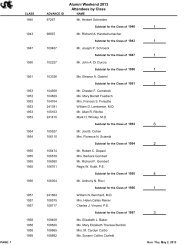
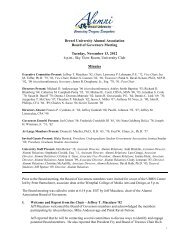

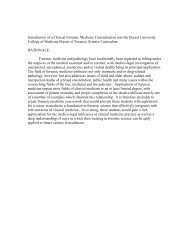
![Inauguration Program [PDF] - Drexel University](https://img.yumpu.com/11418503/1/190x123/inauguration-program-pdf-drexel-university.jpg?quality=85)
